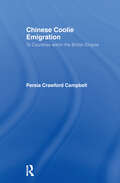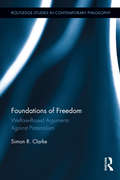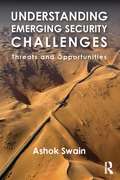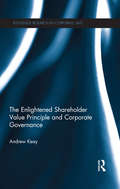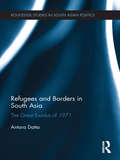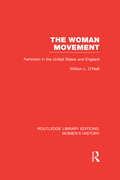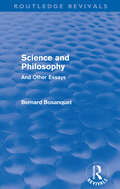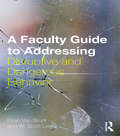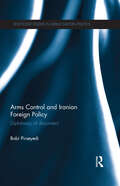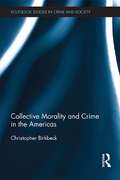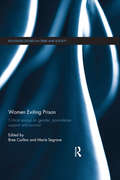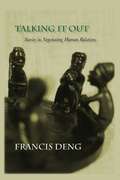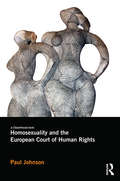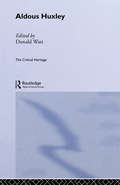Special Collections
Benetech’s Global Certified Accessible Titles
Description: Benetech’s GCA program is the first independent third-party EPUB certification to verify ebook accessibility. By creating content that is born accessible, publishers can meet the needs of all readers. Learn more: https://bornaccessible.benetech.org/
- Table View
- List View
The Coming of Age of the Green Community
by Erik BichardPeople organising to protect their environment is not a new phenomenon, but the groups that have been pushing for environmental change since the 1970s have not convinced sufficient numbers make sustainable decisions or to lead sustainable lives. Governments have serially failed to do the job at the international level. Now, climate change, resource depletion and widening social aspirations threaten to destabilise human society unless sustainable change can be influenced from another direction. The Coming of Age of the Green Community explores the activities of a new generation of community-led initiatives that may herald the beginnings of the next wave of activism. Erik Bichard combines the testimonies of dozens of group activists with historic evidence and the views of a range of commentators from a variety of disciplines to put forward reasons why some green community groups succeed while others fail. He concludes with a valuable prescription for both existing and emerging groups on how to be sustainable, both over time and in their actions. This book address one of the key questions of the twenty-first century: has the local perspective on this universal concern finally come of age?
Essay on History and Management
by James HoleFirst Published in 1970. Routledge is an imprint of Taylor & Francis, an informa company.
On Loyalty
by Troy JollimoreLoyalty is a highly charged and important issue, often evoking strong feelings and actions. What is loyalty? Is loyalty compatible with impartiality? How do we respond to conflicts of loyalties? In a global era, should we be trying to transcend loyalties to particular political communities? Drawing on a fascinating array of literary and cinematic examples - The Remains of the Day, No Country for Old Men, The English Patient, The Third Man, and more - Troy Jollimore expertly unravels the phenomenon of loyalty from a philosophical standpoint. He reflects on the idea that loyalty shapes our very identities, and considers both the benefits and the dangers of loyalty: on the one hand, how excessive loyalty can move us to perform immoral, even evil actions; one the other, how loyalty can expand our lives and give us a sense of meaning and belonging.
Chinese Coolie Emigration to Canada
by Perisa CampbellFirst Published in 1971. Routledge is an imprint of Taylor & Francis, an informa company.
The Origin of Islam in Its Christian Environment
by Richard BellFirst Published in 1968. Routledge is an imprint of Taylor & Francis, an informa company.
Foundations of Freedom
by Simon R. ClarkeWhat makes individual freedom valuable? People have always believed in freedom, have sought it, and have sometimes fought and died for it. The belief that it is something to be valued is widespread. But does this belief have a rational foundation? This book examines answers to these questions that are based on the welfare of the person whose freedom is at stake. There are various conceptions of a worthwhile life, a life that is valuable for the person whose life it is. These conceptions will be examined to see whether they are plausible and what their connection, if any, is to freedom. Are they compelling foundations for freedom? Does freedom make a person’s life better or would his/her welfare be advanced by restricting freedom?
Understanding Emerging Security Challenges
by Ashok SwainThis book offers an overview of emerging security challenges in the global environment in the post-Cold War era. After the fall of the Berlin Wall and the subsequent shifting of international political environment, a new broader concept of security began to gain acceptance. This concept encompassed socio-economic-environmental challenges, such as resource scarcity and climate change, water-sharing issues, deforestation and forest protection measures, food and health security, and large population migration. The book examines the causes and consequences of these emerging security threats, and retains a critical focus on evolving approaches to address these issues. The author attempts to develop a framework for sustainable security in a rapidly changing global political landscape, which seeks to bring states and societies together in a way that addresses weaknesses of the evolving international system. Moreover, through a detailed analysis of the emerging security issues and their pathways, the book further argues that the evolving processes not only pose critical challenges but also provide remarkable opportunity for cooperation and collaboration among and within various stakeholders. This book will be of much interest to students of global security, war and conflict studies, peace studies and IR in general.
The Enlightened Shareholder Value Principle and Corporate Governance
by Andrew KeayThe enlightened shareholder value principle (ESV) was formulated during the comprehensive review of UK company law by the Company Law Steering Group in the late 1990s and early 2000’s and requires directors of companies to act in the collective best interests of shareholders. The principle was taken up by the then UK Government and is now embedded in the Companies Act 2006. The emergence of the principle constitutes an important development in corporate governance, particularly in determining what directors must consider when managing the affairs of their companies. This book explains and analyzes the nature of ESV and its contribution to corporate governance whilst also examining where it fits into the existing theoretical landscape. Andrew Keay traces the development of the principle of ESV and considers it in the context of the existing principles which have historically influenced corporate governance. In doing so, the book draws on several empirical studies thereby enabling us to gauge how the ESV principle is addressed in commercial practice. Keay goes on to compare ESV with the constituency statutes that apply in the US in order to determine whether anything can be learnt from the American experience. The book also assesses the reaction of other jurisdictions to the advent of ESV and considers what impact ESV will have on financial institutions and non-financial institutions in the aftermath of the global financial crisis.
Refugees and Borders in South Asia
by Antara DattaThe crisis in East Pakistan in 1971, which preceded the birth of Bangladesh, led to ten million refugees crossing the border into India. This book argues that this massive influx of refugees within a few short months changed ideas about citizenship and belonging in South Asia. The book looks at how the Indian state, while generously keeping its borders open to the refugees, made it clear that these refugees were different from those generated by Partition, and would not be allowed to settle permanently. It discusses how the state was breaking its ‘effective’ link between refugees and citizenship, and how at the same time a second ‘affective’ border was developing between those living in the border areas, especially in Assam and West Bengal. Moving beyond the refugee narratives created by Partition, this book argues that these ‘effective’ and ‘affective’ borders generated by the refugee crisis in 1971 form part of the longer historical trajectory of the current political debate regarding ‘illegal infiltration’ from Bangladesh . It goes on to analyse the aftermath of the 1971 war and the massive repatriation project undertaken by the governments of India, Pakistan and Bangladesh to examine ways in which questions about minorities and belonging remained unresolved post-1971. The book is an interesting contribution to the history of refugees, border-making and 1971 in South Asia, as well as to studies in politics and international relations.
The Woman Movement
by William L. O'NeillThis unusual book traces the development of the feminist movement in America and, to a lesser extent, in England. The comparison between the movements is enlightening. Professor O’Neill starts with Mary Wollstonecraft and traces the development of the attack on Victorian institutions right up to the 1920s and on to the 'permissive' society in which we live. But the story covers all facets of the movement: the struggle for enfranchisement, for property rights, and education, for working women in industry, for temperance and social reform. These remarkable women leaders live in these pages, but even more in the Documents which form the second part of the book. Here their own voices come to us across the years with a sincerity which gives life to the language of a past age.
Science and Philosophy
by Bernard BosanquetFirst published in 1927, Science and Philosophy: And Other Essays is a collection of individual papers written by Bernard Bosanquet during his highly industrious philosophical life. The collection was put together by Bosanquet’s wife after the death of the writer and remains mostly unaltered with just a few papers added and the order of entries improved. The papers here displayed consist of various contributions Bosanquet made to Mind, the Proceedings of the Aristotelian Society, the International Journal of Ethics and other periodicals, as well as work from volumes of lectures and essays under his own or other editorship. Throughout the collection, Bosanquet considers the relationship between science and philosophy. The two subject areas became increasingly intertwined during Bosanquet’s lifetime as scientific writers grew more interested in the philosophical investigation of the concepts which underlined their work and philosophical thinkers recognised the importance of the relationship between mathematics and logic as well as that between physics and metaphysics. The first essay in this volume discusses this idea explicitly and all subsequent articles may be regarded as essays in support of the main discussion with which the volume opens.
Sex Work
by Sharon Pickering and Alison Gerard and JaneMaree MaherSex work has always attracted policy, public and prurient interest. Currently, legal frameworks in developed countries range from prohibition, through partial legalisation to active regulation. Globalisation has increased women’s mobility between developing and developed countries at the same time as women’s employment opportunities in the developed world are shifting. Family and intimate relationships are being transformed by changing demographics, shifting social mores and new intersections between intimate lives and global markets. Sex work is located at the nexus of new intimacies, shifting employment patterns and changing global mobilities. This volume examines the working lives of contemporary sex workers; their practices, their labour market conditions and their engagement with domestic and international regulatory frameworks. It locates the voices and experiences of workers in Melbourne, Australia, at the centre of the sexual services industry as they reflect on brothels and independent escort work, on working conditions and managers, and on the relationships they form with clients. It offers a new account of sex work where women’s labour and mobility is understood as central in local and global imperatives to offer sexual services. It examines how these new imperatives intersect with, challenge and exceed existing regulatory frameworks for sex work. Sex work: labour, mobility and sexual services draws together the everyday practices of sex workers and the broader global markets in which workers negotiate employment. In bringing together these two important intersecting areas, it offers a grounded and innovative account of sex work which will be of interest to academics and policy makers concerned with sex work, gender studies and the sociology of labour.
A Faculty Guide to Addressing Disruptive and Dangerous Behavior
by Brian Van Brunt and W. Scott LewisCollege and university faculty are asked to serve an increasingly diverse and at-risk population of students. They face disruptive and dangerous behaviors that range from speaking out of turn or misusing technology, to potentially agressive behavior. A Faculty Guide to Addressing Disruptive and Dangerous Behavior provides the practical ideas and guidance necessary to manage and mitigate these behaviors. Grounded in research and theory that addresses the interplay of mental health, substance abuse, and aggression that may enter the college classroom, this accessible book serves as a necessary guide for busy faculty members facing challenging situations in their classrooms. Special features include: Vignettes from seasoned faculty that provide thoughtful reflections and advice from everyday experience. Research-based suggestions and intervention techniques to help faculty better assess, intervene, and manage difficult behavior. Coverage of special populations, including nontraditional, veteran, and millennial students. Discussion of the latest laws and regulations that should affect and inform faculty’s decisions.
Reconceptualizing Deterrence
by Elli LiebermanThis book offers a reconceptualisation of conventional deterrence theory, and applies it to enduring rivalries in the Middle East. The work argues that many of the problems encountered in the development of deterrence theory lay in the fact that it was developed during the Cold War, when the immediate problem it had to address was how to prevent catastrophic nuclear wars. The logic of nuclear deterrence compelled a preoccupation with the problem of stability over credibility; however, because the logic of conventional deterrence is different, the solution of the tension between credibility and stability is achieved by deference to credibility, due to the requirements of reputation and costly signaling. This book aims to narrow the gap between theory and evidence. It explores how a reconceptualization of the theory as a process that culminates in the internalization of deterrence within enduring rivalries is better suited to account for its final success: a finding that has eluded deterrence theorists for long. This interdisciplinary book will be of much interest to students of deterrence theory, strategic studies, international security, Middle Eastern studies and IR in general.
Arms Control and Iranian Foreign Policy
by Bobi PirseyediSince 2003, when the world learned that the Islamic Republic of Iran had succeeded in secretly developing a capability to enrich uranium and separate plutonium, the question of Iran’s nuclear program has ranked high on the international political and arms control agenda. This book studies the IRI’s diplomatic operations in the issue area of arms control and demonstrates how arms control diplomacy has formed an integral part of the IRI’s foreign policy during the various phases of its history. Furthermore, it fills a gap in the research literature on Iran’s foreign and security policies by providing the first comprehensive account of Iranian arms control diplomacy under the Islamic regime. This book aims at reconstructing Iran’s diplomatic operations in four distinct thematic areas of arms control: conventional, chemical, biological, and nuclear arms control. It also looks at the diplomatic means by which the IRI’s leadership has tried to achieve its arms control objectives. This text also seeks to identify and examine the individual objectives that have guided Iranian policy choices in the domain of arms control. Finally, it places the reconstructed Iranian objectives into a broader context by elaborating on the fundamental values or foreign policy goals that the IRI’s arms control objectives have served. This highly informative and thought provoking volume will be valuable reading for students, researchers and academics, as well as for commentators and policy-makers interested in Middle East studies, Iranian studies, international relations and arms control.
Collective Morality and Crime in the Americas
by Christopher BirkbeckThis study examines the ways in which the moral community is "talked into being" in relation to crime, and the objects of concern that typically occupy its attention. It maps the imagined moral universe of the virtuous and the criminal and charts the relations between these two groups in the "history of the present." It examines the calls to action which symbolically endow the moral community with power. And it looks at the character and content of collective moralizing. The source materials are commentaries about crime and criminal justice appearing in selected newspapers across the Americas. The moral "talk" found there is stylized, routine, trivial and occasionally dramatic. It looks nothing like the weightier renderings of morality that derive from the reconstruction of a particular "ethic" or from the systematic probing of values and moral reasoning. And its fuzzy, offhand, unexceptional and frequently unsystematic nature makes it a difficult candidate for explaining either stability or change in crime policies. But moral talk has intrinsic importance as the creator and sustainer of an imagined moral community, a community that symbolizes the existence and vigor of morality itself and confers a crucially important identity on its self-proclaimed members. And moral talk reveals inherent intersections between normative, empirical and technical discourses, highlighting the relationships between morality, science and social engineering. Thus, a prosaic, instrumental, model of morality is particularly strong in North America, but only found in a more abstract form in Latin America, where it sits alongside a stirring vision of morality, more directly anchored in virtue. Research on social problems, moral panics and the sociology of morality has largely overlooked the type of moral discourse studied here. While emphasizing the culturally contingent nature of the findings, the conclusion reflects on their significance for understanding the nature of moralizing, the artifacts of talk and the construction of identity.
AIDS Literature and Gay Identity
by Monica B. PearlThis book discusses the significance of late twentieth century and early twenty first century American fiction written in response to the AIDS crisis and interrogates how sexual identity is depicted and constructed textually. Pearl develops Freudian psychoanalytic theory in a complex account of the ways in which grief is expressed and worked out in literature, showing how key texts from the AIDS crisis by authors such as Edmund White, Michael Cunningham, Eve Sedgwick – and also, later, the archives of The ACT UP Oral History Project - lie both within the tradition of gay writing and a postmodernist poetics. The book demonstrates how literary texts both expose and construct personal identity, how they expose and produce sexual identities, and how gay and queer identities were written onto the page, but also constructed and consolidated by these very texts. Pearl argues that the division between realist and postmodern, and gay and queer, respectively, is determined by whether the experience expressed and accounted is mediated through the psychoanalytic categories of mourning or melancholia, and is marked by a kind of coherence or chaos in the texts themselves. This study presents an important development in scholarly work in gay literary studies, queer theory, and AIDS representation.
Women Exiting Prison
by Marie Segrave and Bree CarltonWomen’s incarceration is on the rise globally and this has significant intergenerational, economic and humanitarian costs for communities across the world. While there have been efforts to implement reform, particularly in countries such as Canada, UK, US and Australia, the growing evidence suggests women’s prisons and the support structures surrounding them are in crisis. This collection of critical essays presents groundbreaking research on women’s post-imprisonment policy, practice and experiences. It is the first collection to offer international perspectives on gender, criminalisation, the effects of imprisonment and women-centred approaches to the short and long-term support of women exiting prison. It offers cutting-edge insights into contemporary policy developments and women’s experiences across the US, the UK, Australia, Canada and Northern Ireland. The collection makes two important contributions. First, it marks a departure from an instrumental and individual focus on ‘what works’ to reduce women’s offending and re-offending behaviour - a prevailing approach within competing collections focused on post-release issues. Second, it presents critical, original research with robust empirical foundations to revive feminist criminological engagement around gender, imprisonment, and most critically, post-release management, support and survival. The collection will appeal to academics and community-based advocates, activists, lawyers and practitioners engaged in advocacy and service provision for imprisoned women. It is also an important and unique analysis for undergraduate and postgraduate students studying criminological and social science courses particularly those related to gender and crime, imprisonment and correctional policy and qualitative research methods.
A Global Standard for Reporting Conflict
by Jake LynchA Global Standard for Reporting Conflict constructs an argument from first principles to identify what constitutes good journalism. It explores and synthesises key concepts from political and communication theory to delineate the role of journalism in public spheres. And it shows how these concepts relate to ideas from peace research, in the form of Peace Journalism. Thinkers whose contributions are examined along the way include Michel Foucault, Johan Galtung, John Paul Lederach, Edward Herman and Noam Chomsky, Manuel Castells and Jurgen Habermas. The book argues for a critical realist approach, considering critiques of ‘correspondence’ theories of representation to propose an innovative conceptualisation of journalistic epistemology in which ‘social truths’ can be identified as the basis for the journalistic remit of factual reporting. If the world cannot be accessed as it is, then it can be assembled as agreed – so long as consensus on important meanings is kept under constant review. These propositions are tested by extensive fieldwork in four countries: Australia, the Philippines, South Africa and Mexico.
Talking It Out
by DengFirst published in 2006. Routledge is an imprint of Taylor & Francis, an informa company.
International Law, Politics and Inhumane Weapons
by Alan BrydenThis book contributes to contemporary debates on the effectiveness of international humanitarian law (IHL) in regulating or prohibiting inhumane weapons, such as landmines. Two treaties have emerged under IHL in response to the humanitarian scourge of landmines. However, despite a considerable body of related literature, clear understandings have not been established on the effectiveness of these international legal frameworks in meeting the challenges that prompted their creation. This book seeks to address this lacuna. An analytical framework grounded in regime theory helps move beyond the limitations in the current literature through a structured focus on principles, norms, rules, procedures, actors and issue areas. On the one hand, this clarifies how political considerations determine opportunities and constraints in designing and implementing IHL regimes. On the other, it enables us to explore how and why ‘ideal’ policy prescriptions are threatened when faced with complex challenges in post-conflict contexts. This book will be of much interest to students of international humanitarian law, global governance, human security and IR in general.
Indigeneity In India
by Bengt G. Karlsson Tanka B. SubbaFirst published in 2006. Routledge is an imprint of Taylor & Francis, an informa company.
Homosexuality and the European Court of Human Rights
by Paul JohnsonHomosexuality and the European Court of Human Rights is the first book-length study of the Court’s jurisprudence in respect of sexual orientation. It offers a socio-legal analysis of the substantial number of decisions and judgments of the Strasbourg organs on the wide range of complaints brought by gay men and lesbians under the European Convention on Human Rights. Providing a systematic analysis of Strasbourg case law since 1955 and examining decades of decisions that have hitherto remained obscure, the book considers the evolution of the Court’s interpretation of the Convention and how this has fashioned lesbian and gay rights in Europe. Going beyond doctrinal analysis by employing a nuanced sociological consideration of Strasbourg jurisprudence, Paul Johnson shows how the Court is a site at which homosexuality is both socially constructed and regulated. He argues that although the Convention is conceived as a ‘living instrument’ to be interpreted ‘in the light of present-day conditions’ the Court’s judgments have frequently forged and advanced new social conditions in respect of homosexuality. Johnson argues that the Court’s jurisprudence has an extra-legal importance because it provides an authoritative and powerful discursive resource that can be mobilized by lesbians and gay men to challenge homophobic and heteronormative social relations in contemporary societies. As such, the book considers how the Court’s interpretation of the Convention might be evolved in the future to better protect lesbian and gay rights and lives.
Engineering Constitutional Change
by Xenophon ContiadesThis volume provides a holistic presentation of the reality of constitutional change in 18 countries (the 15 old EU member states, Canada, Switzerland and the USA). The essays offer analysis on formal and informal constitutional amendment bringing forth the overall picture of the parallel paths constitutional change follows, in correlation to what the constitution means and how constitutional law works. To capture the patterns of constitutional change, multi-faceted parameters are explored such as the interrelations between form of government, party system, and constitutional amendment; the interplay between constitutional change and the system of constitutionality review; the role of the people, civil society, and experts in constitutional change; and the influence of international and European law and jurisprudence on constitutional reform and evolution. In the extensive final, comparative chapter, key features of each country’s amendment procedures are epitomized and the mechanisms of constitutional change are explained on the basis of introducing five distinct models of constitutional change. The concept of constitutional rigidity is re-approached and broken down to a set of factual and institutional rigidities. The classification of countries within models, in accordance with the way in which operative amending mechanisms connect, leads to a succinct portrayal of different modes of constitutional change engineering. This book will prove to be an invaluable tool for approaching constitutional revision either for theoretical or for practical purposes and will be of particular interest to students and scholars of constitutional, comparative and public law.
Aldous Huxley
by Donald WattThis set comprises forty volumes covering nineteenth and twentieth century European and American authors. These volumes will be available as a complete set, mini boxed sets (by theme) or as individual volumes. This second set compliments the first sixty-eight volume set of Critical Heritage published by Routledge in October 1995.



